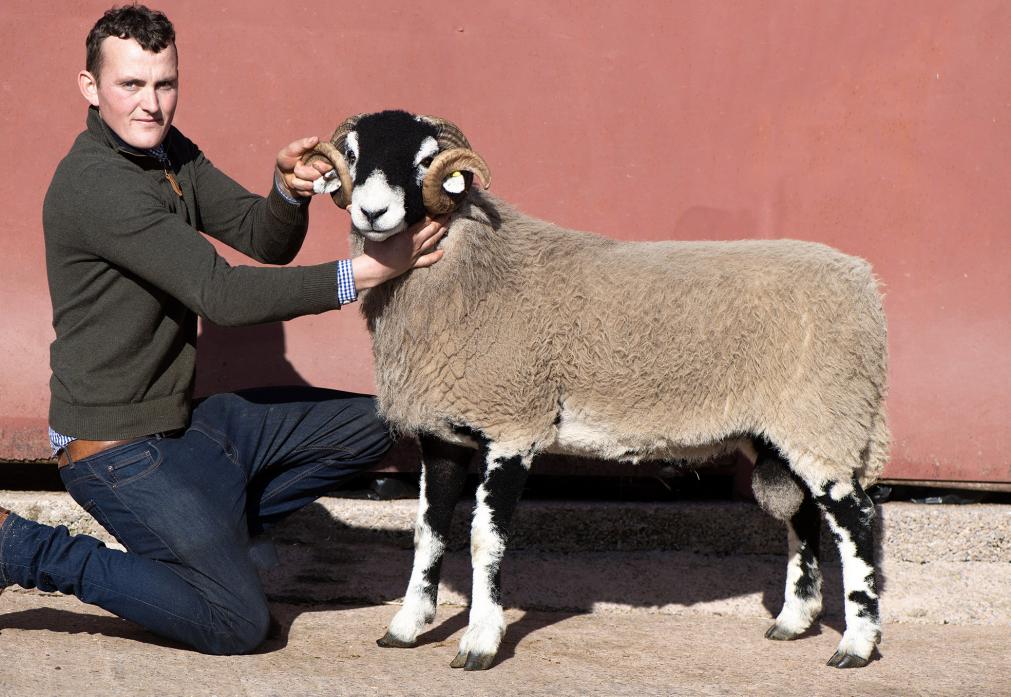
The Allinsons keep a renowned flock of Swaledale sheep, as well as a small suckler herd at West Briscoe, near Cotherstone. Reporter Wendy Short paid them a visit, to talk about their farming policy and to learn about the challenges facing upland holdings in Teesdale
DAVID Allinson’s family moved to the farm in 1938 and he now farms in partnership with his wife Heather and their son Michael; the couple’s other son Bobby is a gamekeeper. The holding covers 450 acres of owned and rented land as well as extensive fell rights, with the main flock comprising 650 Swaledale ewes, which are hefted to the ground that rises behind the farm.
“We have a straightforward approach to the breeding of Swaledales,” says Mr Allinson, chairman of the A District branch of the Swaledale Sheep Breeders Association.
“The main goal is select for correct conformation. In a tup we are looking for size, good teeth and plenty of bone. A Swaledale should also have a broad head, short hard hair and sharply-defined black and white markings on its head and legs.
“Over the past decade there has been a trend towards a lighter-complexioned sheep, but we have stuck with the traditional markings and these are gradually finding favour once more.
“Tups that have done particularly well in recent years include purchases from Paul Ewebank and Mark Ewebank, at Pateley Bridge, and from the Porters, at Summer Lodge, near Richmond. The best rams from the 2019 season were by a Haltcliffe tup, which was bred by Craig Ridley, of Hesket Newmarket, in Cumbria.”
Draft ewes are sold after three crops at Middleton-in-Teesdale to regular buyers. This year saw a new sales venture at Hawes, where the family achieved a flock top price of £520, which was pleasing. They also took a red rosette for the pen of ten at the pre-sale show.
Meanwhile, tups are presented at auction sales including Middleton-in-Teesdale, Hawes and Kirkby Stephen to a mixture of pedigree and commercial buyers.
The Allinsons recently achieved the top price at Kirkby Stephen for a shearling ram by the Craig Ridley tup. Its dam was by a Paul Ewebank tup and it was sold to Geoff and Carol Marwood, of Barningham.
The family has won numerous cups and prizes for the sheep and sell about 20 tups each year. There is also a flock of late March-lambing Texels, which are the special interest of Heather Allinson. They produce quality finished lambs which are in demand in the local marketplace.
The suckler herd policy follows the criss-cross breeding pattern adopted by many of the region’s farms, with mainly Limousin cows put to a Limousin or British Blue bull. Calves from the spring and autumn-calving herd are sold as stores at about 12 months and some of the heifers go on to breeding homes, while a handful will be purchased for commercial showing.
Winters are long at West Briscoe and the cows were housed in mid-October this year. The normal pattern is to bring them in at the beginning of November and turn-out is usually mid-end of May. Thankfully, straw prices have eased back compared with last winter, but bedding still represents a considerable expense, comments Mr Allinson.
Swaledale breeding was a passion with Mr Allinson’s father and it has been passed down to him and on to his son, Michael.
“There is a lot of pleasure to be gained in constantly striving to improve the quality of our flock,” he says. “When it comes to breeding an outstanding tup, there are a multitude of finer points that can make or break his appeal.
“There is no such thing as a perfect animal; it is a question of matching the traits of a tup with an individual ewe and hoping that it will produce something special. That does not happen very often, but when it does it makes all the hard work worthwhile.”
The main flock is lambed in late April/early May, generally with a lambing percentage of about 165. Hay is their staple diet aside from grass in early pregnancy and they will later have access to sugar beet, with concentrate feed given in the six-week run-up to lambing. Scanning takes place in early February, after which the flock is divided into groups according to lamb numbers.
Swaledale gimmer lambs are sold at Middleton-in-Teesdale, with ram lambs left entire, taken to 38-48kgs and mainly sold deadweight. The majority will reach O3L, with some R3L grades, while wethers go through Kirkby Stephen mart around Christmas time.
Some eight graziers run their sheep on the fell, which allocates one ewe and one lamb to each stint. The group works well together, says Mr Allinson, and the shepherds come together for gathering at clipping time and for dipping.
The farm is a member of two Higher Level Stewardship (HLS) schemes. One applies to the moor and terminates in 2020, with the agreement for the in-bye land due to finish the following year. There is a small parcel of land which has been designated an SSSI (Site of Special Scientific Interest).
“The challenge is to breed sound livestock, while also farming with the environment in mind,” he says. “With both the moor and the reservoir in the vicinity, this area is rich in bird life. We have black grouse and large flocks of lapwing, as well as curlew, redshank and other wading birds and we get pleasure out of having them on the farm.
“Black grouse numbers have been steadily increasing in this area for the past few years and we have planted native broadleaved trees and hawthorn, in the hope that providing extra cover will increase the population still further.”
Most of the upland environmental schemes require sheep to be taken off the moors and fells in the winter and West Briscoe is required to house a percentage of the Swaledale ewes.
“We can still out-winter some of the flock on the fell and we hope that will continue, because it is the natural way of keeping the breed. When our two HLS schemes come to an end we will consider re-joining, but we will have to look at the proposals before coming to a decision.
“One issue that I believe gets forgotten is that upland permanent pasture and moorland is almost as effective as trees at conserving carbon. This pasture needs livestock for maintenance, so some of the bad press that sheep and cattle have received is unjustified, I feel. In addition there are implications for food miles and the UK’s carbon footprint if we were to import more meat from abroad.
“This is a man-made landscape and visitors come from far and wide to enjoy it. Farming is a vital aspect of managing the hills as they look today and we are not convinced that the public wants our countryside to return to scrubland.”
Farming, and hill farming in particular, is moving into uncertain times, with the uncertainty surrounding Brexit and also trade deals that could undermine British produce, as well as the phasing out of the basic payment scheme, he points out.
“However, the future of the Swaledale looks fairly bright, partly because of the positive traits of the sheep that are bred from them. The North of England Mule is an extremely popular animal, with many features that suit systems further down the hill; buyers come from all over the country to source Mules from this area,” says Mr Allinson.





